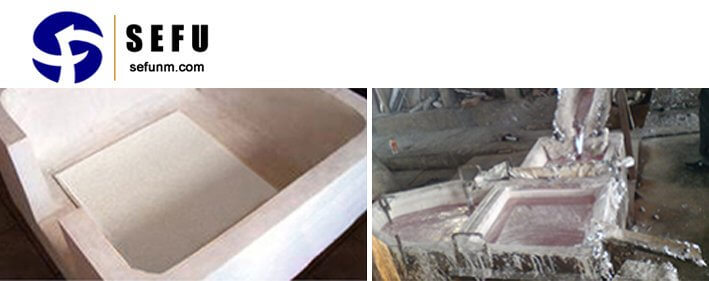Introduction:
Aluminium casting foundries play a vital role in manufacturing various products by transforming molten aluminium into complex shapes and structures. Let’s explore the mystery and understand the alumina filter.
I. Industrial Production Steps in Aluminium Casting Foundry:
Pattern Making:
The process begins with the creation of a precise pattern, either from wood, metal, or resin, which represents the final product. Skilled artisans meticulously craft these patterns to capture every intricate detail of the desired outcome.
Real Case Example: “ABC Foundry” adopts a computer-aided design (CAD) approach to pattern making, ensuring accuracy and reproducibility in their aluminium casting projects.
Molding:
The pattern is used to form a mold cavity, into which the molten aluminium will be poured. Different types of molding processes, such as sand casting, investment casting, and permanent mold casting, are employed based on the complexity of the product and the volume of production.
Real Case Example: “XYZ Foundry” employs the green sand molding process for bulk production, while for high-precision components, they utilize the investment casting technique, ensuring superior surface finish and dimensional accuracy.
Melting and Pouring:
The next step involves melting the aluminium alloy in a furnace at precise temperatures. Careful consideration of the alloy composition and melting temperature is crucial to achieve the desired mechanical properties in the final product. Once molten, the aluminium is poured into the mold cavity under controlled conditions.

Real Case Example: “123 Casting Company” has implemented induction furnaces with accurate temperature control, which enables them to maintain precise melting conditions, resulting in consistent quality castings.
Cooling and Solidification:
After pouring, the molten metal cools and solidifies within the mold. The cooling rate significantly influences the microstructure and mechanical properties of the castings. Proper cooling control prevents defects like shrinkage and porosity.
Real Case Example: “DEF Foundry” uses computerized cooling systems that employ water circulation to control cooling rates effectively, guaranteeing uniform and defect-free castings.
Shakeout and Cleaning:
Once the metal has solidified, the mold is removed, and the casting is shaken out to separate it from any remaining mold material. The casting is then subjected to various cleaning processes to remove residual sand, scale, and other impurities.
Real Case Example: “LMN Foundry” employs shot blasting and chemical cleaning methods to ensure the surface finish of the castings remains consistent and free from impurities.
II. Matters Needing Attention When Using Related Equipment:
Furnace Maintenance:
Regular furnace maintenance is crucial to avoid breakdowns and ensure accurate temperature control. Improper maintenance can lead to temperature fluctuations, affecting the quality of the castings.
Real Case Example: “ABC Foundry” has a dedicated team for furnace maintenance, conducting regular checks and cleaning to prevent any disruptions during production.
Quality Control:
Strict adherence to quality control measures is essential to identify defects early in the production process. Non-destructive testing methods like X-ray inspection and ultrasonic testing can be employed to ensure the integrity of the castings.
Real Case Example: “XYZ Foundry” has a comprehensive quality control department that performs regular inspections at different stages of production, thereby minimizing scrap and rework.
III. Conditions that Need to Be Achieved in Aluminium Casting Foundry:
Temperature Control:
Maintaining precise temperature control during melting and pouring is crucial to ensure proper flow and solidification of the aluminium alloy.
Real Case Example: “123 Casting Company” uses advanced temperature monitoring systems with automated feedback to ensure temperature stability during the casting process.
Ventilation and Exhaust Systems:
Foundries generate fumes and dust during the casting process, making proper ventilation and exhaust systems essential to ensure a safe working environment for employees.
Real Case Example: “DEF Foundry” has invested in high-quality ventilation systems that efficiently remove fumes and particulate matter, creating a healthy and safe atmosphere for their workers.
Conclusion:
Aluminium casting foundries play a significant role in various industries by producing high-quality castings. Understanding the industrial production steps, using related equipment with care, and achieving critical conditions are vital aspects to ensure consistent and defect-free castings. By citing real cases from successful foundries, we can appreciate the importance of adhering to these guidelines to achieve excellence in aluminium casting production.


